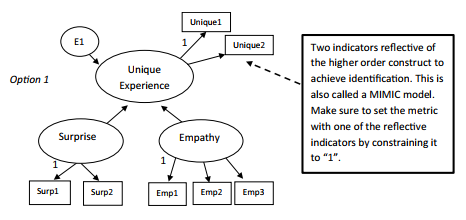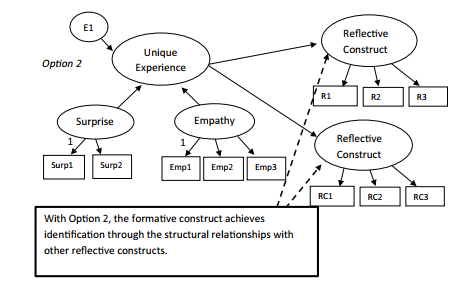A formative construct will have identification problems in SEM if additional steps are not taken. The first way to rectify the identification problem is to include two reflective indica- tors from the formative unobservable construct. These two reflective indicators should try to capture the overall theme of the formative construct.You need to know if your conceptu- alization has a formative construct before data collection takes place, because you will need to ask these dedicated questions solely for identification of the formative construct.This is by far the most preferred way to solve the identification issues of formative constructs.You will also see this technique called a MIMIC model, which stands for multiple indicator multiple cause model. With this type of model, you have both formative and reflective relationships included in the measurement of a concept. The second way to solve the identification prob- lem is to have a relationship from the formative construct to two unobservable constructs in the model that are reflective. In essence, you are achieving identification through the paths to other reflective constructs. See Figure 4.44.

Figure 4.44a Ways to Achieve Identification With a Second Order Formative Construct

Figure 4.44b Ways to Achieve Identification With a Second Order Formative Construct
In My Opinion: Identification With Formative Indicators
In my opinion, the MIMIC model approach is far superior to the option of achiev- ing identification through the structural relationships with other reflective constructs. I have found that the second option of using structural paths for identification will often wreck your model fit and can have adverse effects on your structural relationships. In my previous work, I have tested both methods for identification in a model, and the sec- ond option (structural path for identification) has consistently produced worse results.
If you know you have a formative construct, ask the two identification questions in your survey and use the MIMIC model approach. It is not dependent on other constructs and allows for a cleaner analysis.
Source: Thakkar, J.J. (2020). “Procedural Steps in Structural Equation Modelling”. In: Structural Equation Modelling. Studies in Systems, Decision and Control, vol 285. Springer, Singapore.

28 Mar 2023
20 Sep 2022
28 Mar 2023
29 Mar 2023
29 Mar 2023
27 Mar 2023